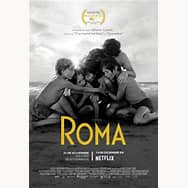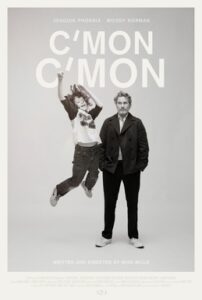 Belfast was the opening film at the recent Philadelphia Film Festival. Directed and written by Kenneth Branagh, it is currently showing on the big screen. Filmed in black and white, it tells the story of Branagh’s childhood in Belfast during 1969 at the beginning of the so-called Troubles in Northern Ireland. It was impossible for me to watch this film without comparing it to Roma (2018), an uncanny similar childhood memory of life in Mexico City during the early seventies directed by Alfonso Cuarón, which coincidentally, was one of the centerpieces of that year’s Film Festival. Roma, as we know, went on to win the Oscar for Best Foreign picture, Best Director and Best Script – among many other awards– and Belfast is being spoken of as a serious contender for this year’s awards.
Belfast was the opening film at the recent Philadelphia Film Festival. Directed and written by Kenneth Branagh, it is currently showing on the big screen. Filmed in black and white, it tells the story of Branagh’s childhood in Belfast during 1969 at the beginning of the so-called Troubles in Northern Ireland. It was impossible for me to watch this film without comparing it to Roma (2018), an uncanny similar childhood memory of life in Mexico City during the early seventies directed by Alfonso Cuarón, which coincidentally, was one of the centerpieces of that year’s Film Festival. Roma, as we know, went on to win the Oscar for Best Foreign picture, Best Director and Best Script – among many other awards– and Belfast is being spoken of as a serious contender for this year’s awards.
Despite the assertion of Jeannette Catsoulis in The New York Times review of Belfast that “Kenneth Branagh recalls his childhood through a rose-tinted lens” (Nov. 1, 2021), there is abundant suffering in the life of nine-year-old Buddy (Jude Hill in a delightful performance). He watches in horror as Molotov cocktails are thrown against his Catholic neighbors and barricades are built. He witnesses the death of his adored grandfather and experiences alienation and confusion when his family is uprooted to England. Granted, that his parents’ marriage and his first school crush are idealized. The lightest aspect of the film, in my view, is in the script with its frequent jokes and cute innocence.
 There is nothing cute about the family situation in Roma. The father abandons his wife and four children. Cleo (the indigenous maid and central character played by Yalitza Aparicio), becomes pregnant and is herself abandoned by the child’s father and she loses her baby. Subsequently, two of the family’s children almost drown in a trip to the beach. All this in the midst of an earthquake and the students’ demonstrations in Mexico City known as the Corpus Christi Massacre of 1971.
There is nothing cute about the family situation in Roma. The father abandons his wife and four children. Cleo (the indigenous maid and central character played by Yalitza Aparicio), becomes pregnant and is herself abandoned by the child’s father and she loses her baby. Subsequently, two of the family’s children almost drown in a trip to the beach. All this in the midst of an earthquake and the students’ demonstrations in Mexico City known as the Corpus Christi Massacre of 1971.
What these two films have in common, in addition to their black and white cinematography and the universal aspect of the memories of both directors as children, is an outstanding restoration by the mise en scène of a particular period of history. Cuarón actually, built a reproduction of his childhood home in order to be faithful to the story. He recreated the furniture, clothing and artifacts in every detail. It is clear that Buddy is a young alter-ego of Kenneth Branagh, but it’s not obvious which one of the three boys in Roma represents Alfonso Cuarón. He could be Paco, the middle boy (Carlos Peralta), who spies when his parents argue, cries when he hears about their impending divorce and looks out forlornly out of the car window after the climactic scene on the beach.
What differentiates these two films is the cinematographic approach of Cuarón’s work with the martial arts sequences, the Christmas party in the countryside, the beach scenes, the incursions into the city and the political demonstrations. While Branagh’s film is almost theatrical, the main space we see is his childhood street with two short scenes in the dance hall and the hospital. Cuarón doesn’t use close-ups of his characters emphasizing the importance of heir milieu, while Branagh’s camera relishes focusing on the beautiful faces of Ma (Caitriona Balfe) and Pa (Jamie Dornan). Also, there is no original score in Roma – we only hear the constant cacophony of the children and the tumultuous noise in the street scenes– whereas Belfast is graced by the music of Van Morrison.
 Interestingly enough, another black and white film at this year’s festival was C’mon C’mon, directed by Mike Mills with Joaquin Phoenix and another delightful child, Jesse, his eight-year-old nephew played by Woody Norman. Filmed in Southern California, New York and New Orleans, Jesse is a quintessential postmodern American boy, who contrasts with his counterparts in the two other films. Jesse knows about abortion, his bipolar dad and, amazingly, understands the difference between fiction and nonfiction. But I digress. Suffice it to say that these children are all carefully watching.
Interestingly enough, another black and white film at this year’s festival was C’mon C’mon, directed by Mike Mills with Joaquin Phoenix and another delightful child, Jesse, his eight-year-old nephew played by Woody Norman. Filmed in Southern California, New York and New Orleans, Jesse is a quintessential postmodern American boy, who contrasts with his counterparts in the two other films. Jesse knows about abortion, his bipolar dad and, amazingly, understands the difference between fiction and nonfiction. But I digress. Suffice it to say that these children are all carefully watching.

The children are not only watching but they are experiencing and learning how to survive as they inevitably will become adults in search of relevance and meaning or as O’Neill wrote said in LDJIN: The past is the present too”.
How right you are, Dick. Thanks for your comment, Concha
Hi, Concha – nice blog post! So, you’re going to the movies again. It’s strange – we’ve been to many concerts but not yet to a movie. Belfast is certainly on our list of what to see, but so are a lot of other things – tough choices!
I thought the Film Fest this year was especially appealing. I enjoy the buzz of seeing films when they are au courant rather than streaming. Of course, some are coming out in both formats at the same time…